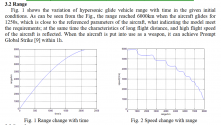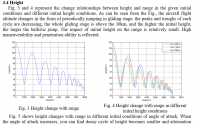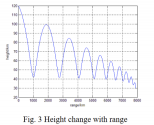You are using an out of date browser. It may not display this or other websites correctly.
You should upgrade or use an alternative browser.
You should upgrade or use an alternative browser.
Chinese Hypersonic Developments (HGVs/HCMs)
- Thread starter A.Man
- Start date
Mach 8 is the average speed here. Entire point of hypersonic gliders is they use aerodynamic lift to prevent altitude loss. By that they can fly in very depressed trajectories. This results in late detection and very tight engagement envelope (both in time and space) for the defender. Another benefit is you can program random or pre-determined maneuvers to even further stress enemy defenses. Furthermore you can combine ballistic and aerodynamic trajectories to achieve very long ranges. Only problem here is they also lose speed while generating lift because being in the atmosphere means drag. So they are much slower at the end of their glide (provided that they were used to their limits)That's only about mach 8. If it has a DF-26 booster like we expect, that's a lot slower than I would have expected.
The distance travelled is by itself pretty uninteresting though, and shouldn't be seen as indicative of anything since that's just the space they have to test it on.
Let's look at the DF-17. We know its post flame-out speed. Mach 10. But look at what we have here:
During the November 1 test flight, which took place from the Jiuquan Space Launcher Center in Inner Mongolia, the missile’s payload flew to a range of approximately 1,400 kilometers with the HGV flying at a depressed altitude of around 60 kilometers following the completion of the DF-17’s ballistic and reentry phases.
So 1400 km in 11 minutes = Mach 6.3The duration of the HGV’s flight was nearly 11 minutes during that test.
Aerodynamic drag, acceleration from 0 and vertical component mean a lot lower average velocity over long range compared to the top speed.
Mach 8 average speed over 2100 km despite maneuvering is very impressive. I think top speed of this HGV is Mach 12-14.
Speed isn’t everything. HGVs all trade speed for much greater freedom of motion. A Mach 8 vehicle with a full range of angular vectors to target is much much harder to intercept than a Mach 15 vehicle with a mostly fixed range of angular vectors to target. Furthermore, flatter flight profiles greatly reduces the horizon detection limit which a defense system can spot the projectile. Once you’re past a certain speed the range and frequency of maneuver are frankly speaking much more impactful variables. Defeating missile defense systems is ultimately about system response time to find an intercept solution, and you can strain that system either by reducing response time headroom or by making the range of potential solutions so large that the probability of the defense system finding the correct solution go down dramatically. If the difference between Mach 8 and Mach 15 is a response time reduction of 2, but a flatter flight profile reduces horizon detection limits by a factor of 3-5, you take the flatter flight profile. And if you can add a decrease in probability of intercept by another factor of 3-5 with greater maneuver range, you are *definitely* taking the Mach 8 HGV projectile over a Mach 15 terminal ballistic projectile. You can play around with those numbers but those are the basic factors shaping decisions about which kinds of projectile designs you want to work on.The terminal speed of a ballistic missile is not its max speed, since like you said atmospheric air resistance exists. With the same booster then, an HGV and a conventional ballistic missile should have roughly the same max speed, but lower terminal speed.
I'm not aware if there's anything specific out in the public in terms of the DF-26's max speed but it should be somewhere in the mach 15 zone. A mach 8 glide would be a significant slowdown, especially compared to the DF-17, which has a glide speed only slightly slower than its max speed.
To drive the point home even further, I would add that you can even swap out your Mach 15 example for a Mach 25+ example, and your value proposition would still hold in favor of the Mach 8 HGV. Lowered detection radius and increased maneuverability are just THAT important for striking imperialist scum with impunity.Speed isn’t everything. HGVs all trade speed for much greater freedom of motion. A Mach 8 vehicle with a full range of angular vectors to target is much much harder to intercept than a Mach 15 vehicle with a mostly fixed range of angular vectors to target. Furthermore, flatter flight profiles greatly reduces the horizon detection limit which a defense system can spot the projectile. Once you’re past a certain speed the range and frequency of maneuver are frankly speaking much more impactful variables. Defeating missile defense systems is ultimately about system response time to find an intercept solution, and you can strain that system either by reducing response time headroom or by making the range of potential solutions so large that the probability of the defense system finding the correct solution go down dramatically. If the difference between Mach 8 and Mach 15 is a response time reduction of 2, but a flatter flight profile reduces horizon detection limits by a factor of 3-5, you take the flatter flight profile. And if you can add a decrease in probability of intercept by another factor of 3-5 with greater maneuver range, you are *definitely* taking the Mach 8 HGV projectile over a Mach 15 terminal ballistic projectile. You can play around with those numbers but those are the basic factors shaping decisions about which kinds of projectile designs you want to work on.
Yes, especially since reaching Mach 25 also usually means reaching higher ballistic trajectory which means much much greater horizon detection limit.To drive the point home even further, I would add that you can even swap out your Mach 15 example for a Mach 25+ example, and your value proposition would still hold in favor of the Mach 8 HGV.
What you argued against may not be right, but your counter argument is wrong too.
My conclusion is that it is pointless to try to deduce something from the "leak" because it provided absolutely nothing. Whatever conclusion any opposing sides try to make is likely to be wrong in one way or the other.
BTW, what I said above is based on a college text book from China.
The speed that you calculated from the "leak" is not meaningful because you don't know what that duration of time is measured. The "leak" only gave a time duration and distance without saying at what stage of the flight they are measured. US sensor saw the missile at a point does not mean the missile was launched or begin to glide at that point in time and space.The low average speed this time is simply due to the low range,
One should not assume anything from the "leak" since it did not state how the distance is measured, at what stage of the flight the warhead was detected by the US asset. There is simply nothing to judge from.were it at full range then it would be much higher,
If we take NASA's definition of atmosphere boundary at 180km. Most studied HGV trajectories do NOT leave the atmosphere, therefor no reentry. Even the 12000km intercontinental alternative reaches far lower than 180km.initial reentry speed about the same as the IRBM.
My conclusion is that it is pointless to try to deduce something from the "leak" because it provided absolutely nothing. Whatever conclusion any opposing sides try to make is likely to be wrong in one way or the other.
BTW, what I said above is based on a college text book from China.
Pelosi better switch off her infrared-heated toys when the war broke out.China have largest hypersonic infrastructure in the world with extensive spending on this tech. so we can expect more high hypersonic missiles in coming years. they also claimed to breakthrough in next generation hypersonic. heat seeking tech
Heat-seeking capability allows Chinese hypersonic missiles to home in on almost any target – including stealth aircraft, aircraft carriers and moving vehicles on the street – with unprecedented accuracy and speed, according to the researchers.
Take this open sourced research from China as an example:

Then the HGV warhead continues to suffer speed loss due to air drag and its impact speed is only around 1000m/s, 3Ma.
However, it is continuously “jumping" within layers of atmosphere to trick the detecting radar. The paper only discusses about a periodic vertical maneuvering and the flight test was doing both vertical and horizontal maneuvering to add more uncertainty on its trajectory but of course will reduce the gliding range.

The paper assumes booster stage burnout at a velocity of 5874 m/s at the height of 120km so the maximum ballistic range is around 5,000 km, a.k.a a hypothetical US IRBM which currently doesn't deploy yet but similar to DF-26. The hypothetical HGV has a maximum range of 8,000km.In this paper, a US hypersonic glide vehicle for the study, ignoring the Earth's rotation and perturbation. In fact, the boost phase process of reentry gliding aircraft and ballistic missiles are the same, so only the reentry gliding segment model is established.

Then the HGV warhead continues to suffer speed loss due to air drag and its impact speed is only around 1000m/s, 3Ma.
However, it is continuously “jumping" within layers of atmosphere to trick the detecting radar. The paper only discusses about a periodic vertical maneuvering and the flight test was doing both vertical and horizontal maneuvering to add more uncertainty on its trajectory but of course will reduce the gliding range.

Paper might be about Orion. It successfully demonstrated skip glide.Take this open sourced research from China as an example:
The paper assumes booster stage burnout at a velocity of 5874 m/s at the height of 120km so the maximum ballistic range is around 5,000 km, a.k.a a hypothetical US IRBM which currently doesn't deploy yet but similar to DF-26. The hypothetical HGV has a maximum range of 8,000km.
View attachment 110872
Then the HGV warhead continues to suffer speed loss due to air drag and its impact speed is only around 1000m/s, 3Ma.
However, it is continuously “jumping" within layers of atmosphere to trick the detecting radar. The paper only discusses about a periodic vertical maneuvering and the flight test was doing both vertical and horizontal maneuvering to add more uncertainty on its trajectory but of course will reduce the gliding range.
View attachment 110873

